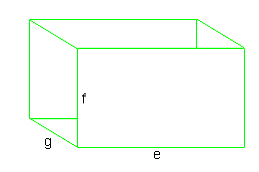
Surface Area Formulas
The addition of all the shapes that cover the surface of the object is called the surface area of the object. Calculating the surface area will also help you to know the exposed area of a solid object. However, the definition of surface area varies for different structures. For instance in case of Polyhedra, the surface area is the total area of its faces whereas in case of smooth surfaces, surface area is the representation of parametric surfaces.
Surface Area of a Cube

(a is the length of the side of each edge of the cube)
If you want to calculate the area of a cube then it’s always better to see each surface as a square and a cube is made up of six equal squares. Considering each side of the square as “aâ€, the area of each square is a2. Therefore, the area of the cube will be 6a2
Surface area of a Rectangular Prism

(e, f, and g are the lengths of the 3 sides)
The area of a rectangular prism is the addition of the areas of all the faces. However, in case of rectangular prism, not all the faces are equal in size but the opposite sides are equal to each other. As a result, you have to calculate the area of any of the two sides, which are equal.
The area of the top and bottom will be g x e that is ge. However, there are two faces and as a result the total area of the top and bottom will be 2ge. Similarly, the total area of the front and the back will be 2fe and the sides will be 2fg.
Hence, the total surface area of the surface area of the rectangular prism will be 2ge + 2fe + 2fg. If we replace the sides with a, b and c, we can say 2ab + 2bc + 2ac
Surface Area of Any Prism

(b is the shape of the ends)
Surface Area = Lateral area + Area of two ends
(Lateral area) = (perimeter of shape b) x L
Surface Area = (perimeter of shape b) x L+ 2(Area of shape b)
The surface area of a prism is the sum of lateral area and the area of two ends. In order to calculate the lateral area you have to multiply the perimeter of the shape b with the length L. Once, you get the lateral area you can also get the total area of shape b by multiplying it with 2 as there are two shape b faces. Once you get those, it will be very easy to calculate the area by the formula, b is the shape of the ends)
Surface Area = (perimeter of shape b) x L+ 2(Area of shape b)
Surface Area of a Sphere

The formula to calculate the area of sphere is 4 r2 where r is the radius. For instance, if you want to know the area of a circle then you need to know the measurement of the radius only. Suppose, the radius of a sphere is 21 cm. Therefore the area will be, 4
r2 where r is the radius. For instance, if you want to know the area of a circle then you need to know the measurement of the radius only. Suppose, the radius of a sphere is 21 cm. Therefore the area will be, 4 r2 that is 4 x 22/7 x 212 , as the value of
r2 that is 4 x 22/7 x 212 , as the value of  Â is 22/7
 is 22/7
= 4 x 22/7 x 21 x 21
= 4 x 22 x 3 x 21
= 5544 cm2
Surface Area of a Cylinder

(h is the height of the cylinder, r is the radius of the top)
If you consider the structure of a cylinder then it mainly consists of two circles at the two ends and a curved surface with a height. This structure segmentation is also used in calculating the area of a cylinder. Therefore, the formula to calculate the surface area of a cylinder is 2( r2) + (2
r2) + (2  r) x h. It can be even easier if you take into account that that the area of top and bottom are same. Therefore, you are required to measure the area of any one surface and then twice it to get the total area of the top and bottom.
r) x h. It can be even easier if you take into account that that the area of top and bottom are same. Therefore, you are required to measure the area of any one surface and then twice it to get the total area of the top and bottom.



